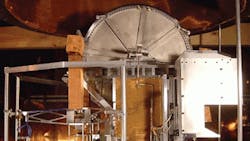SI revisions coming soon
In the initial phases of what is hoped to be a major advance in the science of measurement, the National Institute of Standards and Technology (NIST) is taking part in an international effort to recommend key revisions to the International System of Units (SI), the modern metric system that is the basis of global measurements in commerce and science. The new SI, which would be based on seven constants of nature, would enable researchers around the world to express the results of measurements at new levels of consistency and accuracy.
The most significant change involves the kilogram, the only one of the SI's seven base units still defined in terms of a material “artifact” — a 130-year-old platinum-iridium cylinder maintained at the International Bureau of Weights and Measures in France. The kilogram artifact poses long-term problems because its mass changes slightly over time. In the current SI, it's not just the unit of mass that depends on the kilogram: Definitions of the ampere, mole, and candela ultimately depend on the platinum-iridium artifact. For example, a mole is currently defined as the number of carbon-12 atoms for which total mass is 12 grams.
With the new proposal, the kilogram is defined in terms of the Planck constant h, an important constant in quantum physics, which is expressed in units containing the kilogram. Efforts at NIST such as the watt balance experiment and determinations of the mass of one mole of silicon atoms offer new ways of determining an accurate value of h, thereby contributing to a more reliable definition of the kilogram.
The new SI would specify agreed-upon values of the seven constants, according to the results of an analysis published by CODATA (Committee on Data for Science and Technology) of all relevant data. Fixed values of constants would then define all base units. For example, the ampere would be formally defined in terms of the electric charge of a proton, the kelvin in terms of the Boltzmann constant, and the mole in terms of the Avogadro constant. A draft resolution for the new SI was approved in October, and will be submitted for consideration during next October's General Conference on Weights and Measures general meeting. If the resolution passes, and all technical requirements are in place, a new SI could be in place later this decade.
